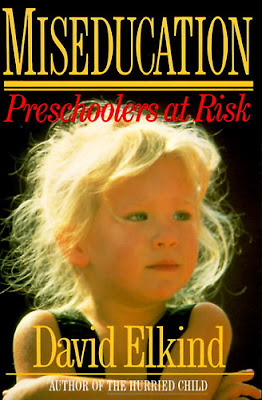This 200+ page book is organized into four parts: Education and Miseducation (Chapter 1), The Social Dynamics of Miseducation (Chapters 2-4), The Risks of Miseducation (Chapters 5-7), and Healthy Education (Chapters 8-9). In Chapter one Dr. Elkind lays out his argument that early instruction teaches the wrong things at the wrong time. In Chapter two Dr. Elkind describes eight different kinds of parents and the mistakes they make. Chapter three covers what we have considered being the competent child over the last several decades. Chapter four is focused on computer education, and it is extremely dated (the book was published in 1987) and rather comical. Chapters 5-7 examines the first three stages of Erik Erickson's social development stages. In Chapter eight Dr. Elkind provides practical suggestions for making the right choices for the education of your child. The last chapter consists of 30 questions parents have asked Dr. Elkind that he answers.
So what is my take on the book? I started kindergarten at the age of four and was the youngest in my class. I am very thankful that my parents started me early in school, but that does not mean I did not have issues. I still have lots of issues, but don't we all? Our daughters have summer or fall birthdays, and we chose to start them in a school setting a year after many parents might have. Each parent needs to evaluate their child and see what is best for them. We and others believe our youngest daughter, a kindergartner, could find success in the current first-grade class, but we want our Grace to continue to be in an early childhood environment before she is pushed to complete homework and miss out on a lot of playtimes. There are definitely some advantages for delaying formal schooling; however, my wife did provide some formal instruction for Grace before she started attending school. Dr. Elkind is not a fan of this. I think it is important to examine each child and if they find formal learning to be a fun activity, why wouldn't you provide this?
If you don't have little tots runnin' around your house or school and never will, this book is probably not going to be of much interest to you. If you are a "tiger mom" you will probably hate this book with the passion of your tiger heart. Although we delayed the formal schooling of both of our daughters, I feel Dr. Elkind made some broad sweeping statements. There are definitely many parents out there pushing their kids to accomplish tasks that they are not ready for. There are also many parents out there not doing enough. There needs to be a balance as in many things in life. I think with nearly 25 years have passed since the last version of Miseducation, an update is in order.





